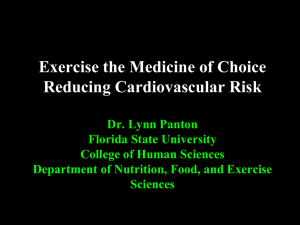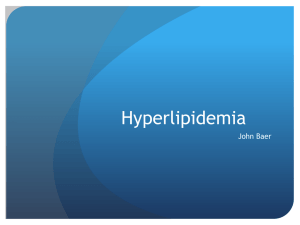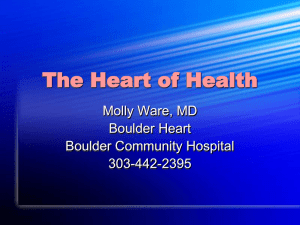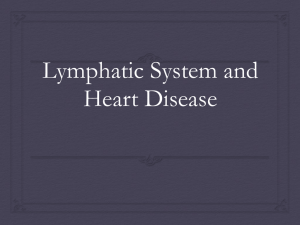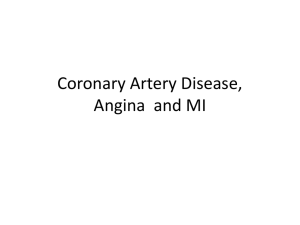Diet and Health Guidelines to Lower Risk of Cardiovascular Disease
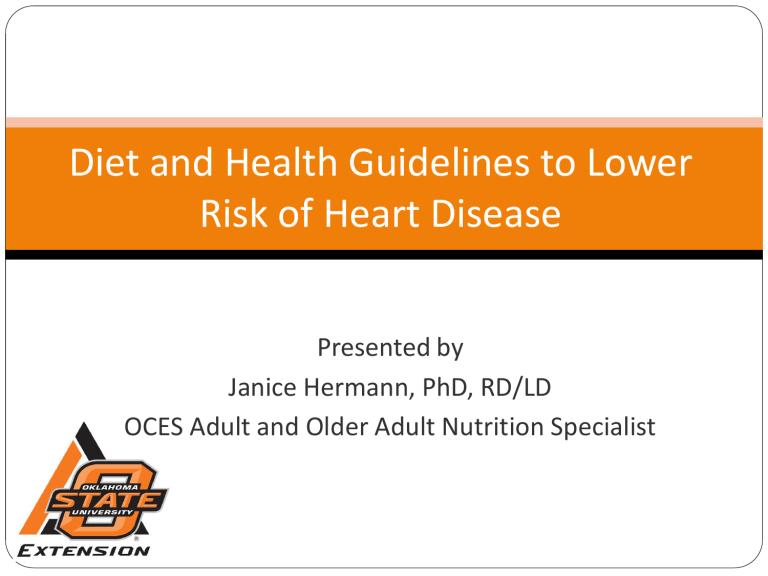
Diet and Health Guidelines to Lower
Risk of Heart Disease
Presented by
Janice Hermann, PhD, RD/LD
OCES Adult and Older Adult Nutrition Specialist
Cardiovascular Disease
Cardiovascular disease describes diseases of the heart and blood vessels
Coronary heart disease
Stoke
Hypertension
Congestive heart failure
Cardiovascular Disease
Coronary heart disease is the most common form of cardiovascular disease
Usually caused by atherosclerosis
Stroke is the second most common form of cardiovascular disease
Atherosclerosis
Thickening of the blood vessel walls due to plaque formation (accumulation of lipids, smooth muscle cells, minerals and fibrous connective tissue)
Atherosclerosis Development
Initiated by minimal but chronic injuries that damage the blood vessel lining
Oxidized LDL cholesterol accumulates in blood vessel wall
Blood vessel damage causes inflammation
Immune system responds sending white blood cells
White blood cells enter blood vessel wall, engulf LDL cholesterol, forming foam cells
Foam cells visible as fatty deposits along blood vessel wall, known as fatty streaks
Atherosclerosis Development
Smooth muscle cells from blood vessel tissue stimulated to divide, engulf LDL cholesterol and form fibrous connective tissue
Plaque accumulates calcium and cholesterol in lipid core can crystallize and harden
Sometimes the blood vessel may expand outward to accommodate the plaque volume; other times plaque narrows the blood vessel lumen
Atherosclerosis Development
Atherosclerosis
Development
Injury
Oxidized LDL accumulates
Damage causes inflammation
Immune system responds with white blood cells
Engulf LDL cholesterol forming foam cells
Smooth muscle proliferation
Lipid, mineral accumulation
Maturation of lesion
Inflammation and Infection
As mentioned plaque formation is initiated by an inflammatory response to injuries that damage the blood vessel lining
There is also evidence that persistent infection may contribute to plaque formation
This has led to the use of markers indicating artery wall inflammation
A promising marker is a protein known as Creactive protein (CRP), which is produced during the acute phase of inflammation
Plaque
Plaque can exist in two forms:
A stable form
Has a thicker barrier between its lipid core and the blood vessel lumen
Blood vessels that accommodate plaque only by narrowing may impede blood flow, but generally have more stable plaque
An unstable plaque
Has a thin barrier which is highly susceptible to rupture resulting in blood clot formation
Blood vessels that accommodate plaque by expanding are less likely to interfere with blood flow but generally have unstable plaque
Blood Clots
Blood clots can enlarge over time obstructing blood flow or a clot may break free and travel through the circulatory system until it lodges in a narrowed artery
and obstruct blood flow
When blood flow is obstructed the surrounding tissue is deprived of oxygen which results in cell death
Heart – heart attack
Brain – stroke
Lung – pulmonary embolism
Kidney – acute renal failure
Aneurysm
Atherosclerosis also is a risk factor for aneurysms
An aneurysm is an abnormal enlargement within the blood vessel
Plaque can weaken the blood vessel wall, allowing it to expand and balloon out
Aneurysms that go undetected can rupture and lead to massive bleeding and death
Coronary Heart Disease Risk Factors
Some factors initiate atherosclerosis by:
Causing direct damage to the artery wall
Allowing lipid materials to penetrate artery surface
Other factors promote progression of atherosclerosis and related complications by inducing:
Plaque rupture
Blood clotting
Coronary Heart Disease Risk Factors
Non modifiable risk factors:
Increasing age
Gender
Family history of premature heart disease
Modifiable risk factors:
High LDL cholesterol
Low HDL cholesterol
High blood pressure
Diabetes
Obesity (especially abdominal obesity)
Physical inactivity
Cigarette smoking
Diet high in saturated fat, trans fat, and cholesterol and low in fruits, vegetables and whole grains
Preventing Coronary Heart Disease
For most people, preventing coronary heart disease focuses on lowering modifiable risk factors
Studies have suggested that 80 to 90 percent of people with severe heart disease have at least one of the four classic risk factors:
High LDL cholesterol
High blood pressure
Diabetes
Smoking
Age
Aging strongly associated with atherosclerosis due to:
Cumulative exposure to risk factors
Degeneration of blood vessels with age
Aging becomes a significant risk factor for:
Men at age 45 or older,
Women at age 55 or older as they reach menopause
Gender
Gender difference in age of coronary heart disease onset has been attributed to:
A protective effect of estrogen in women
Men also tend to have other possible risk factors:
Higher homocysteine levels
Higher risk of iron overload
Ultimately, coronary heart disease kills as many women as men
Family History
Family history of early coronary heart disease in one’s immediate family members is an independent risk factor, independent of other risk factors
LDL cholesterol
LDL cholesterol is easily oxidized
Oxidized LDL cholesterol is actively taken up and retained in the blood vessel wall
Oxidized LDL has other damaging effects:
Activate proliferation of smooth muscle cells involved in plaque formation
Induce vasoconstriction (increase blood pressure)
Simulate blood clotting
Inhibit some normal protective functions of HDL
LDL cholesterol
High levels of a variant form of LDL called lipoprotein(a) has been found to accelerate progression atherosclerosis and double the risk of coronary heart disease
Abnormally high levels are largely genetically determined and have been associated with premature development of heart disease
LDL Cholesterol Levels
High LDL cholesterol ≥ 160 mg/dL
Recommended LDL cholesterol < 100 mg/dL
HDL Cholesterol
HDL carries cholesterol from body cells to the liver to be removed and thus protects against atherosclerosis
Low HDL cholesterol is a risk factor for coronary heart disease
Low HDL cholesterol levels often coexist with other risk factors such as high triglycerides
Some factors that increase coronary heart disease risk such as obesity, smoking, inactivity and male gender also reduce HDL
HDL Cholesterol
Low HDL < 40 mg/dL
Recommended HDL ≥ 60 mg/dL
Blood Pressure
The stress of blood flow along the blood vessel walls (shear stress) can cause mechanical damage within the blood vessel
Plaque tends to develop at points where blood vessels branch or bend disturbing blood flow
High blood pressure intensifies the stress of blood flow on arterial walls
Plaque protruding inward can reduced blood flow and raise blood pressure even further
Thus, hypertension and atherosclerosis become mutually aggravating conditions
Blood Pressure
For people over 50 years of age, a high systolic blood pressure is more predictive of coronary heart disease risk than diastolic blood pressure
High blood pressure is ≥140/ ≥90 mm Hg
Recommended blood pressure is <120/<80
Diabetes
High blood glucose can attach (glycate) to proteins forming glycoproteins
These proteins can damage blood vessels and worsen atherosclerosis
Other effects of diabetes promote blood clot formation
Diabetes
High fasting blood glucose is ≥ 126 mg/dL
Recommended fasting blood glucose is < 100 mg/dL
High 2 hr OGT blood glucose is ≥ 200 mg/dL
Recommended 2 hr OGT blood glucose is
< 140 mg/dL
Obesity (Especially Abdominal)
Obesity, especially abdominal obesity, increases the risk of coronary heart disease by:
Increasing blood pressure
Increasing insulin resistance
Increasing risk of diabetes
Increasing LDL cholesterol
Increasing triglycerides
Lowering HDL cholesterol
Alters concentration and activity of blood clotting factors promoting blood clotting
Obesity (Especially Abdominal)
Overweight = BMI 25.0-29.9
Obese = BMI ≥ 30
Recommended BMI = 18.5 – 24.9
Recommended waist circumference is:
Men: <102 cm (<40 in)
Women: <88 cm (<35 in)
Obesity
The initial goal of a weight-loss program is no more than 10% of original body weight
For some, avoiding additional weight gain may be a desirable starting point
Physical Inactivity
Physical inactivity can increase risk of:
Low HDL cholesterol
Obesity
which can increase the risk of:
D iabetes
High blood pressure
Regular physical activity can lower coronary heart disease risk:
Increase HDL
Lower LDL cholesterol
Lower triglycerides
Promote weight loss
Improve insulin sensitivity
Lower blood pressure
Strengthen heart muscles
Physical Activity
Aerobic activities help the heart the most
Goal is to expend at least 2,000 calories in physical activity per week
Dietary Guidelines physical activity recommendations:
For substantial health benefits
150 minutes of moderate-intensity per week or
75 minutes of vigorous-intensity per week
For additional health benefits
300 minutes of moderate-intensity per week or
150 minutes of vigorous-intensity per week
Cigarette Smoking
Substances in smoke:
Induce vasoconstriction
Increase blood pressure
Damage blood vessels
Injure blood vessel walls
Increase oxidative stress
Promote LDL cholesterol oxidation
Damage platelets
Promote blood clotting
Decrease oxygen carrying capacity of blood
Promote lipid accumulation in blood vessel walls
Cigarette Smoking
Passive smoke has similar effects
Recommendations are to not start smoking or to quit smoking and to avoid second hand smoke
Quitting smoking can improve coronary heart disease risk almost immediately, and people who stop smoking can eventually reverse the damage from smoking
Diet
A diet high in saturated fat, trans fat, and cholesterol and low in fruits and vegetables, and whole grains is associated with increased coronary heart disease risk, even more than might be expected based on risk factors such as
LDL cholesterol alone
High in nutrients that increase coronary heart disease risk such as saturated fat, trans fat and cholesterol
Low in nutrients that decrease coronary heart disease risk such as fiber, omega-3 fatty acids, and antioxidants
Saturated Fat
Saturated fat has the strongest effect of all lipids on blood LDL cholesterol levels
Clinical trials suggest every 1% increase in calories from saturated fat raises LDL cholesterol 2%
Saturated Fat
Replacing saturated fat with monounsaturated or polyunsaturated fats can lower LDL cholesterol levels
Polyunsaturated fats have a slightly greater effect on lowering LDL cholesterol, but can also promote a slight reduction in HDL cholesterol
Saturated Fat
Average American diet provides 11% of total calories from saturated fat
Main sources of saturated fat are whole-milk products, high fat meats, and baked goods
Recommendations are to choose lean meats or fish, use fat-free or low-fat milk products, limit snack foods and bakery products high in saturated fat
Saturated Fat
Replacing saturated fats with carbohydrates can also reduce LDL cholesterol but may lower HDL cholesterol and raise triglycerides
This effect can be offset somewhat by limiting added sugars and including fiber-rich foods; generous amounts of whole grains, legumes, fruits and vegetables
DRI recommended carbohydrate intake is 45-65% of total calories
Saturated Fat
Dietary Guidelines recommendations are:
Total fat
20 to 35% total calories
Saturated fat
< 10% total calories
Saturated Fat - Tropical Oils
Although, liquid a room temperature, tropical oils are highly saturated
Coconut oil (92% saturated)
Palm kernel (82% saturated)
Palm oils (50% saturated)
Saturated Fat - Steric Acid
Stearic acid is a saturated fatty acid that is mainly in animal products, and some plant foods like chocolate
Studies have shown saturated fatty acids raise blood cholesterol
However, other studies show that some saturated fatty acids like stearic acid may not affect or ay even lower total blood cholesterol
Further research is needed
Saturated Fat - Hydrogenated Fats
Process of hydrogenation changes a liquid oil, naturally high in unsaturated fatty acids, to a more solid and more saturated fat
The greater the degree of hydrogenation, the more saturated the fat becomes
Trans Fat
Trans fat result from hydrogenation of vegetable oils
Unsaturated bonds change from a cis to trans configuration
Trans fats are unsaturated, but they can raise
LDL cholesterol
When trans fats replace saturated fats in the diet they can lower HDL cholesterol
Trans Fat
Most sources of trans fats are products made with partially hydrogenated oils
Baked goods like crackers, cookies, and doughnuts, and fried foods like french fries and fried chicken
Soft margarines and other products are now available with little, or no, trans fat
Current trans fat intakes average about 2.6% of calories
Dietary Guideline recommendations are to keep trans fat intake as low as possible
Dietary Cholesterol
Although saturated fat is the main culprit in raising blood cholesterol, dietary cholesterol plays a part
Dietary cholesterol also raise LDL cholesterol, but not as much as saturated fat
Dietary Cholesterol
People get cholesterol in two ways:
Liver production
About 1,000 mg/day
Foods also contain cholesterol
Average intake 331 mg/day men and 211 mg/day women
Animal products (egg yolk, meat, poultry, fish seafood, whole milk dairy products) contain cholesterol
Plant foods (fruits, vegetables, grains, nuts and seeds) do not contain cholesterol
Dietary Cholesterol
Dietary Guideline recommendations are:
Limit dietary cholesterol intake to < 300 mg/day
Soluble Fiber
When eaten as part of a diet low in saturated fat, trans fat and cholesterol, soluble fiber has been shown to help lower blood cholesterol
Soluble fibers can:
Reduce cholesterol and bile absorption by binding them in the intestinal tract
May also influence the liver’s production of cholesterol by other means
Soluble Fiber
Dietary sources of soluble fiber include oats, barley, legumes, and fruits
The soluble fiber from psyllium seed husks is also effective for lowering cholesterol levels
Fiber
Dietary fiber intake in the United States averages about 15 g/day
Many organizations recommend dietary fiber intake should be 20 – 30 g/day
DRI for fiber is 14 g/1,000 calories
Would be 28 g for a typical 2,000 calorie diet
Omega-3 Fatty Acids
Fatty fish are high in two omega-3 fatty acids:
Eicosapentaenoic acid (EPA)
Docosahexaenoic acid (DHA)
Fatty fish
Mackerel
Lake trout
Herring
Sardines
Albacore tuna
Salmon
Omega-3 Fatty Acids
Omega-3 fatty acids may be beneficial by:
Suppressing inflammatory response
Reducing blood clotting time
Stabilizing heart rhythm
Lowering triglyceride levels
Large intakes of EPA and DHA, however, may raise LDL cholesterol in some people
Increasing omega-3 fatty acids through foods is preferred to supplements
Not all studies with fish oil supplements have reported positive outcomes
Omega-3 Fatty Acids
Omega-3 fatty acids found in flaxseeds and other land plants have lesser or different effects than omega-3 fatty acids from marine sources
Although limited evidence suggests these plant sources of omega-3 fatty acids may lower coronary heart disease risk, more research is needed to confirm their benefits
Antioxidants
Oxidized LDL is especially atherogenic
Epidemiological studies suggest an association between diets rich in antioxidants
(fruits, vegetables and whole grains) and lower coronary heart disease risk
However, antioxidant rich diets are often linked with a healthy lifestyle and lower body weight making it difficult to determine which factor is responsible for the effect
Antioxidants
Controlled trials with single antioxidant supplements (vitamin C and E), combinations, or multivitamins have produced results too weak or inconsistent to conclude that they offer any significant benefit for preventing coronary heart disease, and several studies have suggested possible harm
Recommendations are to eat a diet rich in fruits, vegetables and whole grains
Alcohol
Coronary heart disease risk is lower for people who drink moderate amounts than nondrinkers
Moderate amounts of alcohol has favorable effects on:
HDL cholesterol levels
Atherosclerosis
Inflammation
Blood clotting activity
Alcohol
Moderate intake defined as:
1 drink for women or 2 drinks for men/day
One drink is:
1 ½ fl oz of 80 proof
1 fl oz 100 proof
4 fl oz wine
12 fl oz beer
Alcohol
Too much alcohol:
Raise blood pressure
Raise blood triglycerides
Contribute to obesity
Associated with certain types of cancer
Gastrointestinal tract
Liver
Breast
Ovarian
For these reasons, nondrinkers are not encouraged to start drinking in an effort to decrease coronary heart disease risk
Soy
Several studies have shown diets low in saturated fat and cholesterol and high in soy protein can reduce LDL cholesterol levels, especially when soy protein replaces foods that contain animal fats
Approximately 25 grams of soy protein daily appears to be needed for significant benefit
Whether the LDL lowering effect is due to soy protein alone or to other components of soy, such as isoflavone or sapoinins, remains unclear
Plant Sterols
Plant sterols can lower blood cholesterol
Reduce intestinal absorption of cholesterol, both dietary cholesterol and cholesterol in bile
Clinical trials have shown a little more than one tablespoon of margarine daily (containing about 2 grams of plant sterols) can lower LDL cholesterol by 6-15% without lowering HDL cholesterol
One concern is plant sterols may also reduce absorption and blood levels of carotenoids
Unknown if eating more fruits and vegetables could compensate
Plant Sterols
Plant sterols are extracted from soybeans and pine-tree oils
They can be hydrogenated to produce plant stanols, which are compounds typically found in commercial products
Food manufacturers have designed margarines, cheese, and other products with added plant sterols
Folate acid, B
6
and B
12
High homocysteine levels related to atherosclerosis and coronary heart disease risk
Folate, B
6 and B
12 help break down and lower homocysteine in the body
Use of folate, B
6 and B
12 supplements to reduce coronary heart disease risk is not recommended
Recommendations are to get enough folate, B
6
B
12 in the diet from fruits and green leafy vegetables and
Emerging Coronary Heart Disease
Risk Factors
There are other emerging physiological factors that appear to influence coronary heart disease risk:
Metabolic syndrome
Hypertriglyceridemia
Homocysteine
Iron Overload
Metabolic Syndrome
Metabolic syndrome is a condition of having three or more of the following abnormalities:
Abdominal obesity
Waist circumference > 40 inches (men)
Waist circumference > 35 inches (women)
Serum triglycerides ≥ 150 mg/dl
HDL < 40 mg/dl in men or < 50 mg/dl in women
Blood pressure ≥ 135/85 mm Hg
Serum glucose ≥ 110 mg/dl
Metabolic Syndrome
Each of these factors increases the likelihood of developing coronary heart disease independently, but when they occur together, they elevate risk synergistically
Estimates are that approximately 24% of the population have metabolic syndrome
Metabolic Syndrome
Recommendations for people with metabolic syndrome are:
Weight loss to achieve BMI less than 25 to support reduced abdominal obesity, reduce triglycerides, and reduce blood pressure
Increased physical activity to support weight loss, glucose control, reduce triglycerides, reduce blood pressure and increase HDL cholesterol
Healthy eating habits that support weight loss, glucose control, reduce blood pressure and reduce triglycerides
Triglycerides
Whether high triglycerides are an independent risk factor for coronary heart disease remains debatable
High triglycerides is common in people with metabolic syndrome and diabetes
High triglycerides are associated with low HDL
Overweight, sedentary lifestyle, and cigarette smoking all may raise triglyceride levels
Dietary factors that influence triglycerides the most are high intakes of carbohydrate (≥60% of total calories) and alcohol
Triglycerides
High blood triglycerides is ≥ 200 mg/dL
Recommended blood triglycerides is < 150 mg/dL
Triglycerides
High blood triglycerides is ≥ 200 mg/dL
Recommended blood triglycerides is < 150 mg/dL
Homocysteine
High homocysteine related to atherosclerosis and coronary heart disease risk
Damage blood vessel walls
Increase oxidative stress
Increase blood clotting activity
Uncertain whether harmful effects caused by homocysteine or something associated with it
Folate, B
6 and B
12 help break down homocysteine in the body
Iron Overload
Iron overload, more common in men, is associated with increase coronary heart disease risk
Iron overload increases oxidative stress
More research is needed to understand iron’s role in coronary heart disease

